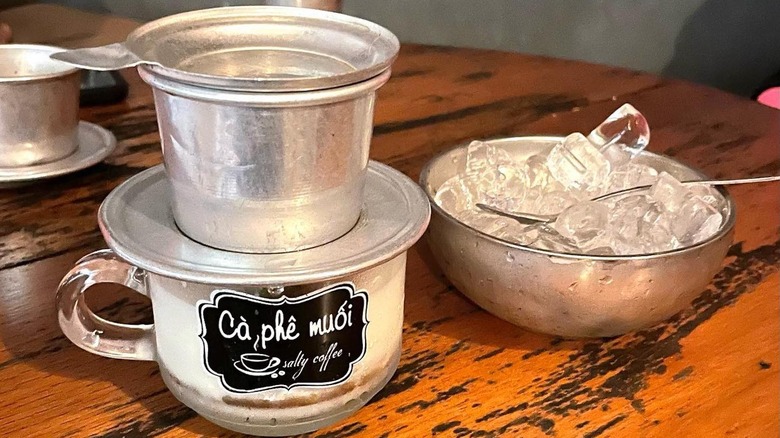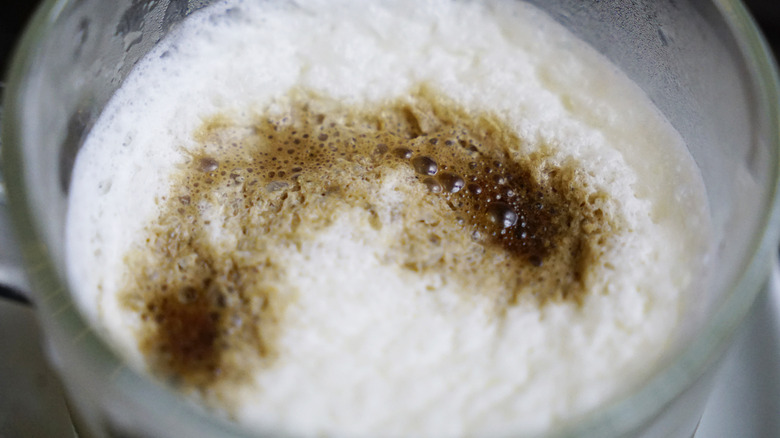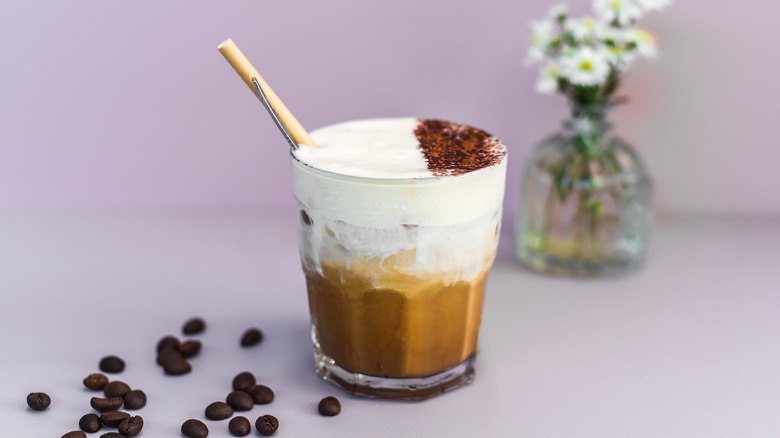Salted Coffee: The Modern Vietnamese Cafe Trend With Fabled Origins
Adding salt to coffee sounds more like something you'd do to prank someone. Yet surprisingly, when done right, the result can be a brew sensational enough to spark a national craze — which is exactly what happened with Vietnam's salted coffee.
The drink itself is rather simple: Standard Vietnamese iced coffee is brewed using a filter called a phin (which utilizes a gravity press) and added to a thick layer of condensed milk at the bottom of the cup as a sweetener. The magic touch is a frothy top layer of salted cream made from heavy cream, condensed milk, and salt. Stirring the coffee blends the salty cream with the robust, bittersweet flavors of the beans and condensed milk. You'll notice the boldness of Robusta (Canephora) beans mellowed by creamy sweetness, punctuated by intriguing hints of salinity that aren't overpowering. Note that this method has nothing to do with Alton Brown's dash-of-salt trick. The salt is added as a key flavoring ingredient, not to fend off the bitterness of the brew.
Salted coffee only started appearing widely in cafés, especially in the 2010s in the historic city of Hue, but it has become a must-try for visitors to this part of the country ever since. If you're a culinary lore buff and ask locals what the drink's all about, you'll get many stories ranging from clear myths to more plausible histories. Whatever the drink's origins, you'll have quite a lot to mull over as you sip.
The folk-ish love stories behind salted coffee
Depending on who you talk to, you'll hear different origin stories for salted coffee, many of which are entwined into the fabric of romance that defines Hue, a city famed for its poetic charm, which also used to be the capital of Vietnam. One popular tale tells of a newlywed fisherman whose wife, a bit nervous after the wedding, mistook the sugar for salt and added a sprinkle to her husband's coffee. To spare her feelings, he praised the brew, and from then on, salted coffee became their household norm. Eventually, he wholeheartedly embraced it, and the popular coffee drink allegedly took root from there.
Another version involves a nervous young man on his first date who added salt to his coffee as an anxiolytic. Observing this, the girl (whom he eventually married) started adding salt to his coffee herself, and he drank every cup 'til the last drop. It was only after his passing that the wife learned, through a letter, that he never actually enjoyed the drink at all, but kept drinking it out of love.
Is it likely that either of these stories is true? Probably not. But they sure lend a degree of sweetness to a drink that, at least by name, sounds like it could be tough to swallow.
So what are the real stories?
The true origin of salted coffee, while a topic of debate, is generally attributed to a couple who own a quaint coffee shop in Hue. Around 2012, Mr. Tran Nguyen Huu Phong and Mrs. Ho Thi Thanh Huong invented the drink as a strategy to attract more customers to their shop. Their idea was a brilliant success, and their café, aptly named Cà Phê Muối, or "Salted Coffee," quickly became one of the city's most famous spots. Tour guides often recommend it as the go-to place for an "authentic" salted coffee experience.
Despite the drink's rising popularity, the couple chose not to patent it or take measures to protect the concept. As a result, once salted coffee caught on, it rapidly spread across Hue and even reached nearby cities like Danang and Hoi An. Today, salted coffee is a staple on the menus of coffeehouses throughout Vietnam's South Central Coast.
While the widespread popularity of salted coffee did divert some clientele from their original shop, Phong and Hương's café remains a beloved institution in the community. They've kept the exact recipe that made their drink famous a closely guarded secret. So, while many places (including streetside carts) serve salted coffee, the salty brew that you can get here just might be the most archetypal you can find in Vietnam.


